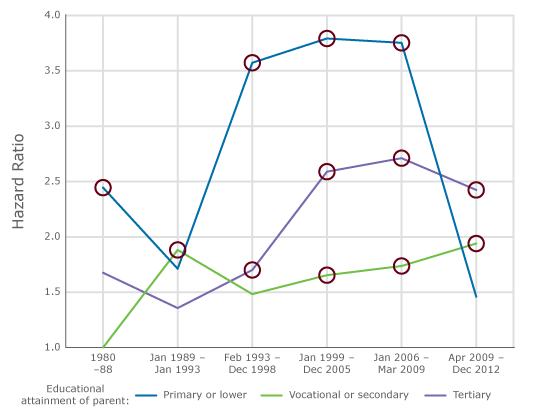In Hungary as in several Central and Eastern European countries, a steep fall in birth rates in the post-socialist period has led to targeted policy measures aimed at curbing the fertility decline and counterbalancing the increased costs of children. Since 1993, Hungarian parents who have a third child with whom they stay at home may draw on a flat-rate cash support paid from the youngest child’s third to eighth birthdays. In 1999, the government introduced a new tax rebate depending on the number of children; this reform benefits parents with taxable income and at least three children. The aim of the first measure was to assist large low-income families, though it effectively encouraged stay-at-home motherhood; the second, by contrast, was presented with the explicit goal of increasing the birth rate.
In a study published this past December, Zsolt Spéder and Lívia Murinkó of the Hungarian Demographic Research Institute and Livia Sz. Oláh of Stockholm University (SUDA) used data from the Hungarian Generations and Gender Survey to study whether these policies increased the likelihood of women in Hungary giving birth to a third child. They also considered the role of educational attainment, more specifically the combined effect of education and the policies mentioned above. To assess possible effects of the cash support and tax relief policies on third births, they specified separate policy periods for the analysis, as the “stay-at-home motherhood” policy was introduced several years before the tax relief policy.
The introduction of the “stay-at-home motherhood” cash support was associated with a significantly higher third birth risk, notwithstanding major social transformation after the end of state socialism in the 1990s. The authors conclude that even during turbulent times, a well-targeted measure may support higher birth rates. Indeed, parents with lower education levels demonstrated the highest third birth rates from 1993 onwards. When the tax relief policy was introduced in 1999 and upgraded thereafter, third birth rates increased significantly among parents with tertiary education. Those with lesser education demonstrated a much less pronounced response to the tax relief measure.

Figure 1: The joint effects of policy period and parental educational attainment on third births in Hungary, 1980–2012
In summary, Spéder et al found that flat-rate payment during the third to eighth birthdays likely supported higher third birth rates among parents with lower socioeconomic status, while the tax relief measure encouraged parents with higher education levels to have more than two children. The option to drop out of the labor force has probably been less appealing to highly educated mothers, unlike taking advantage of the full tax relief benefits that accompany their higher income. Through these findings, the researchers demonstrate the potential effects of family policies on fertility even during periods of societal transition characterized by high uncertainty.